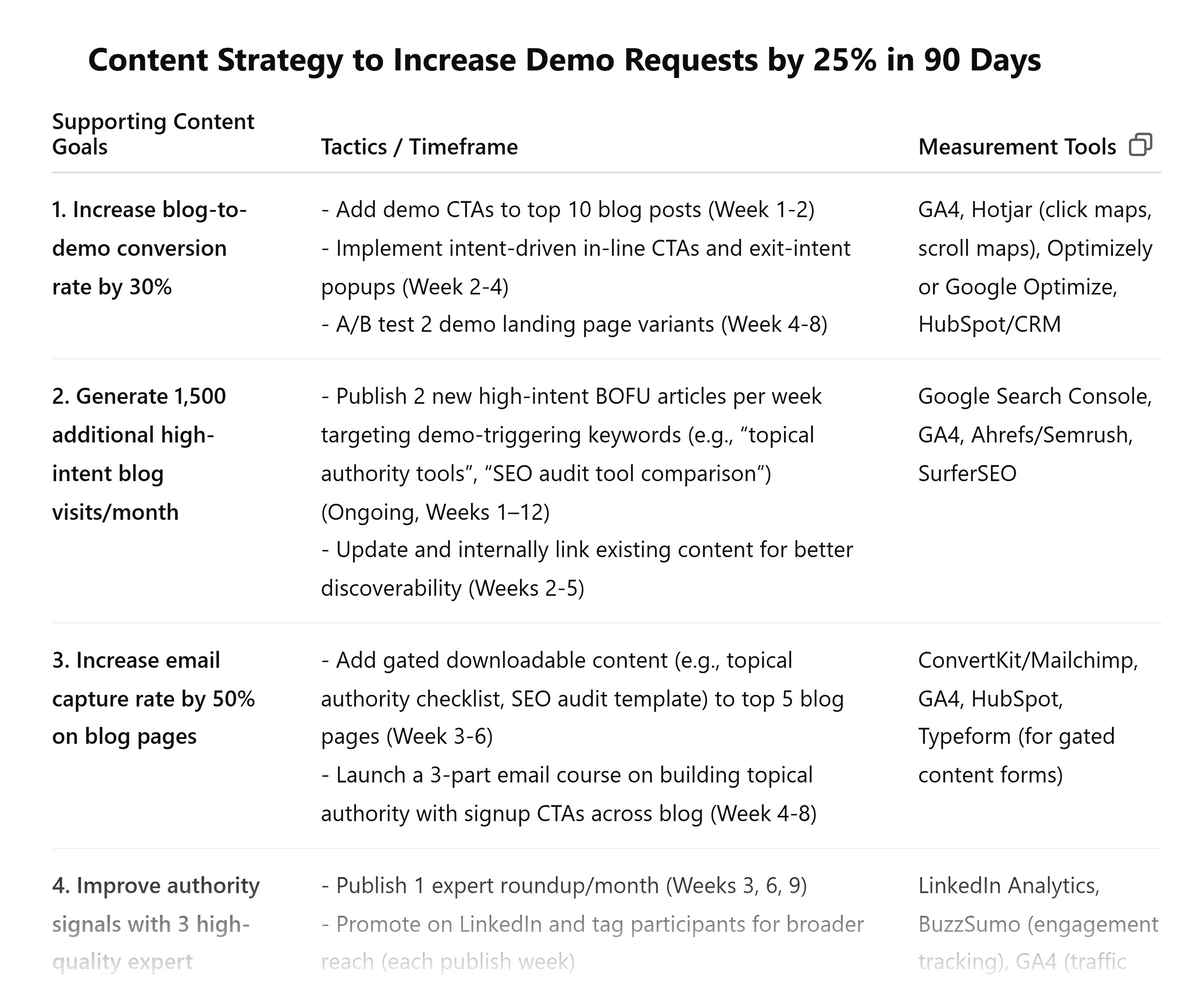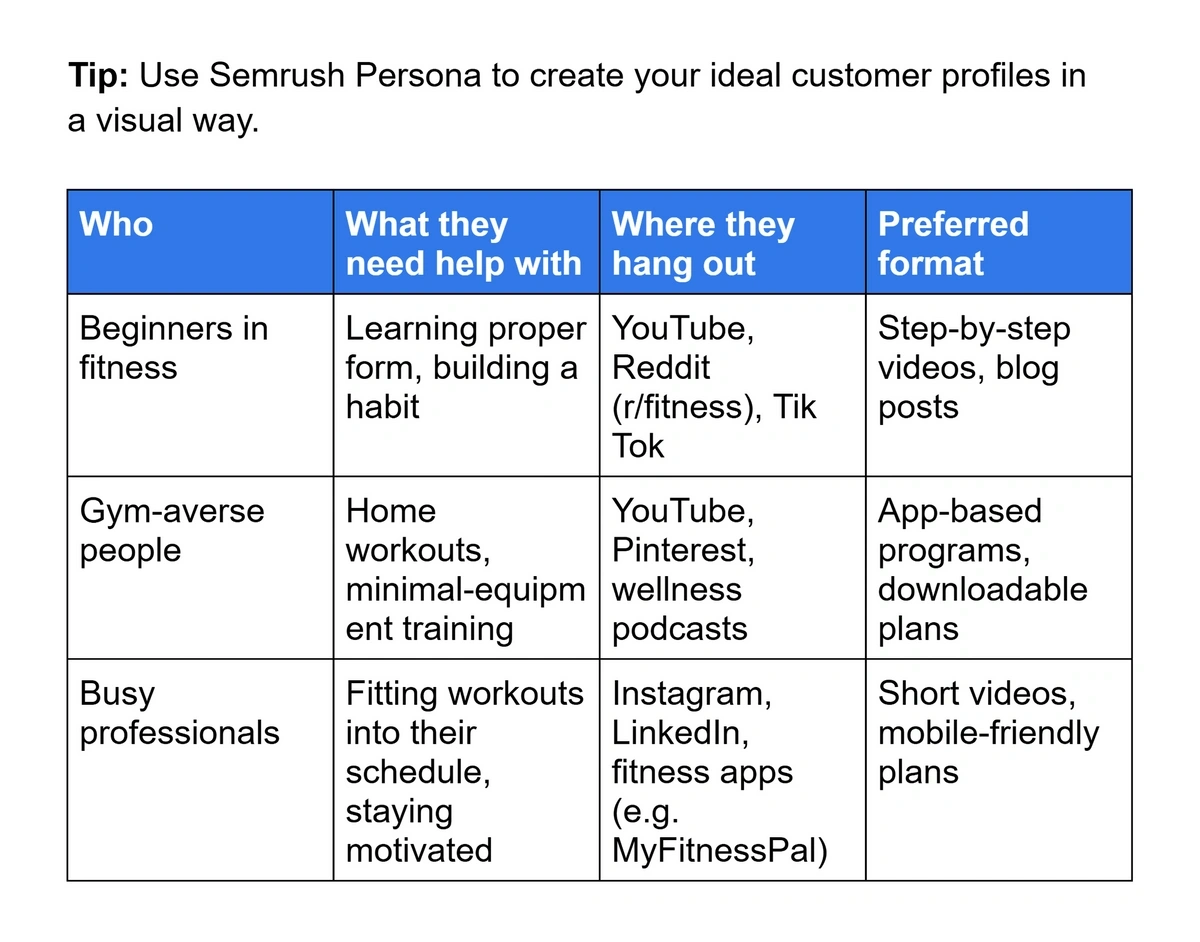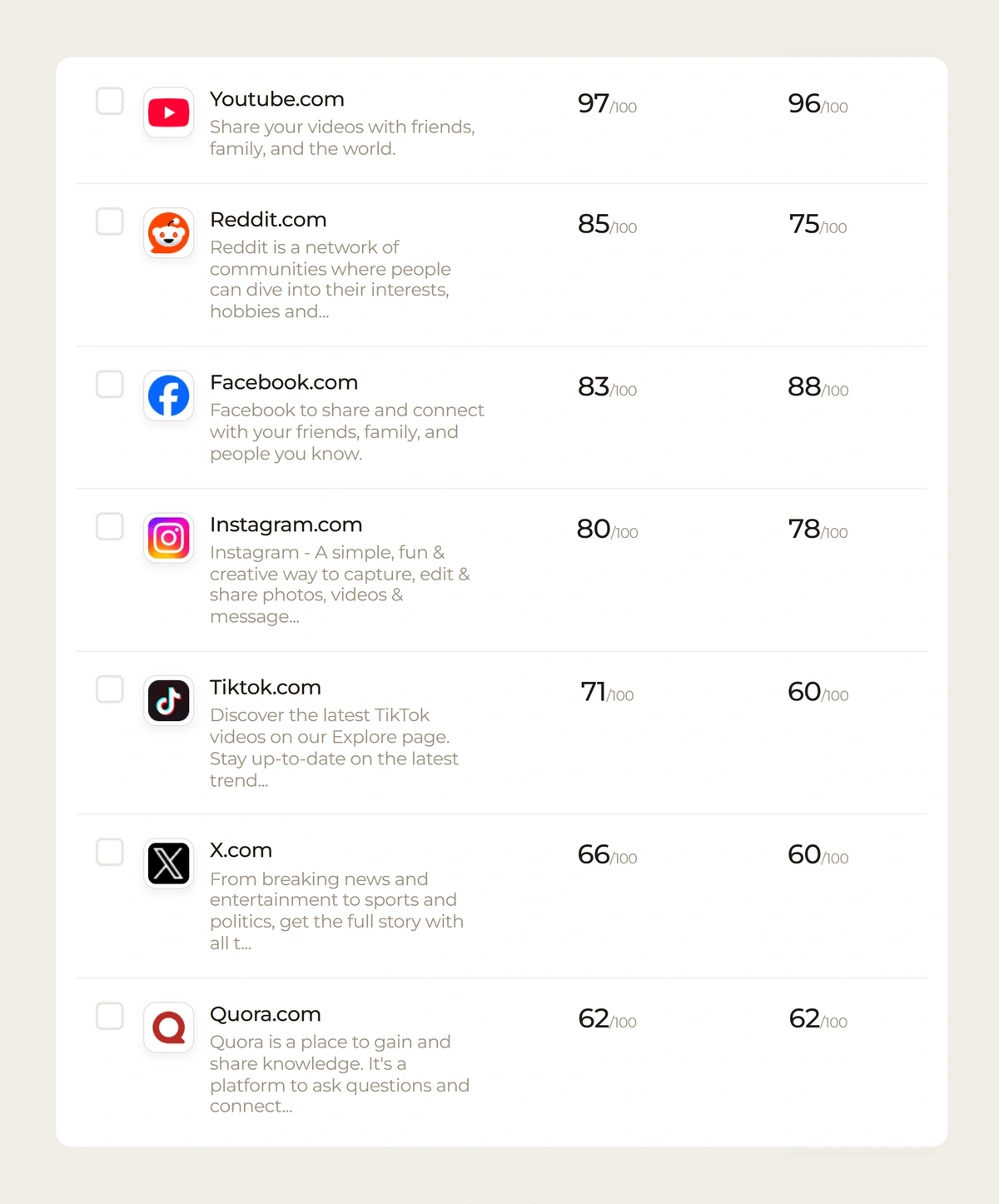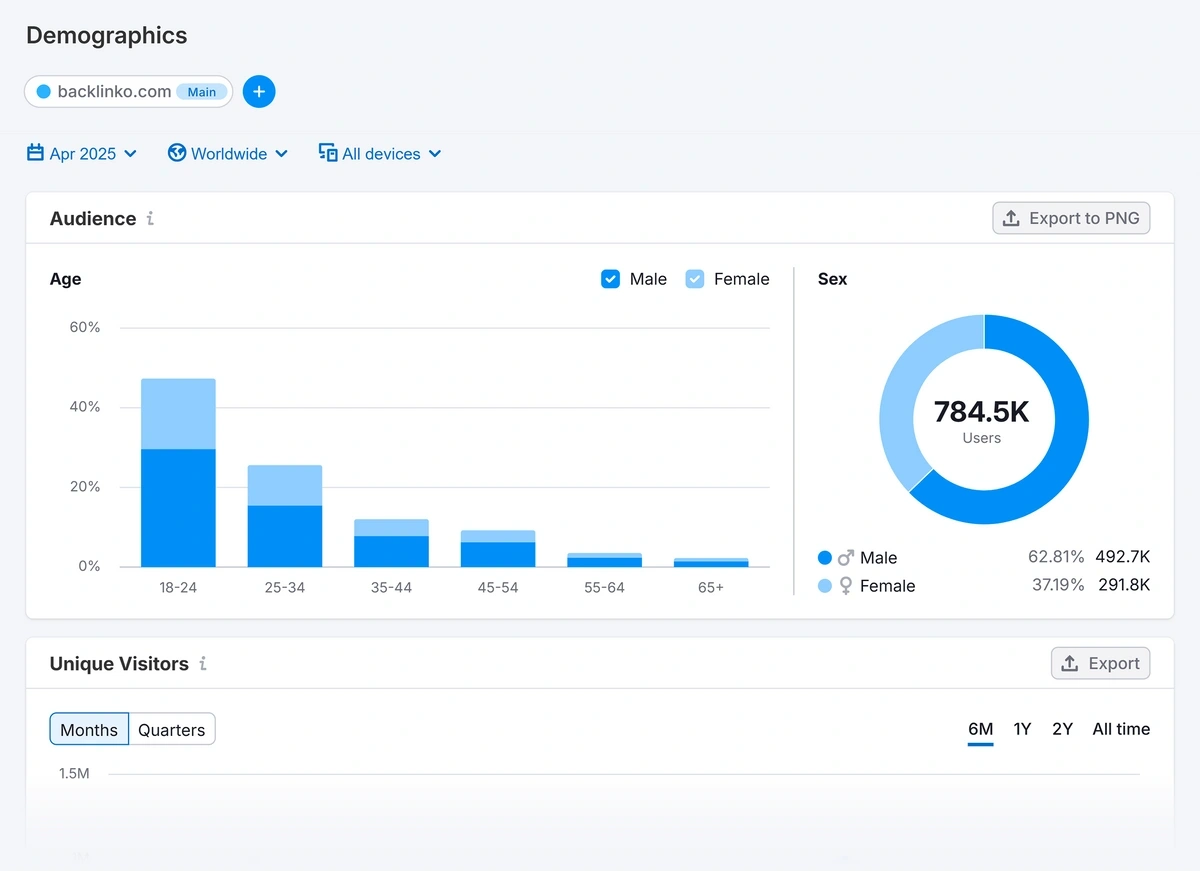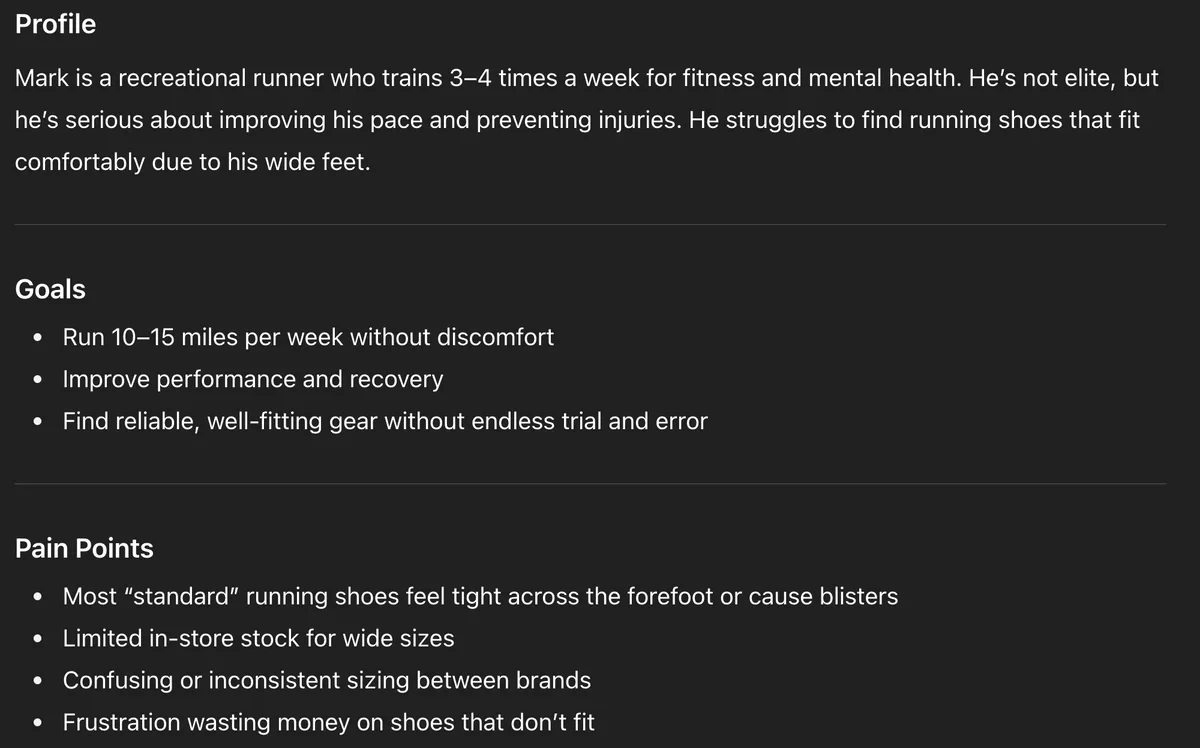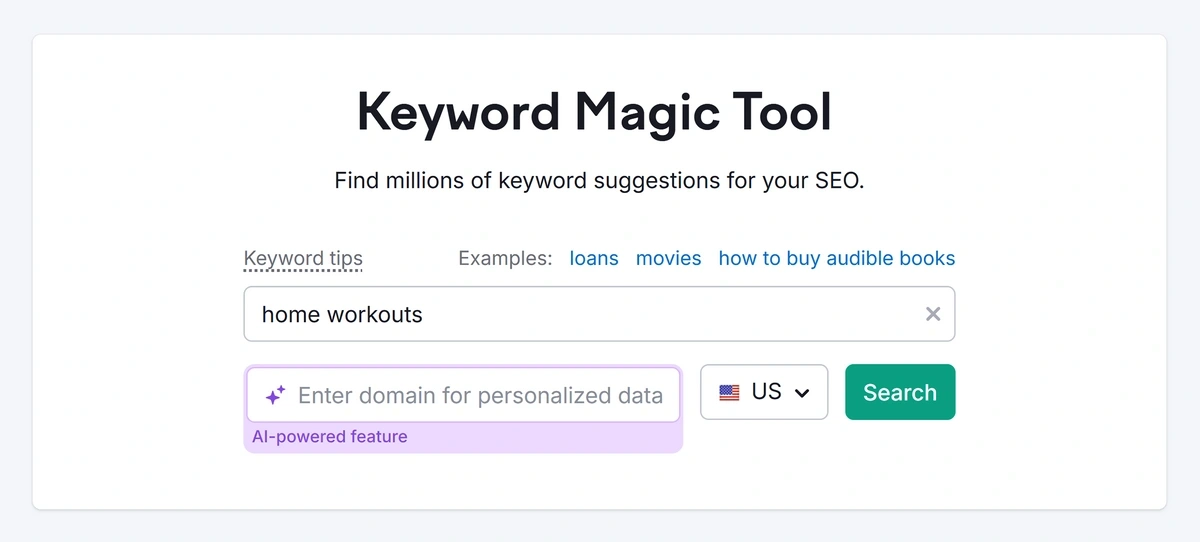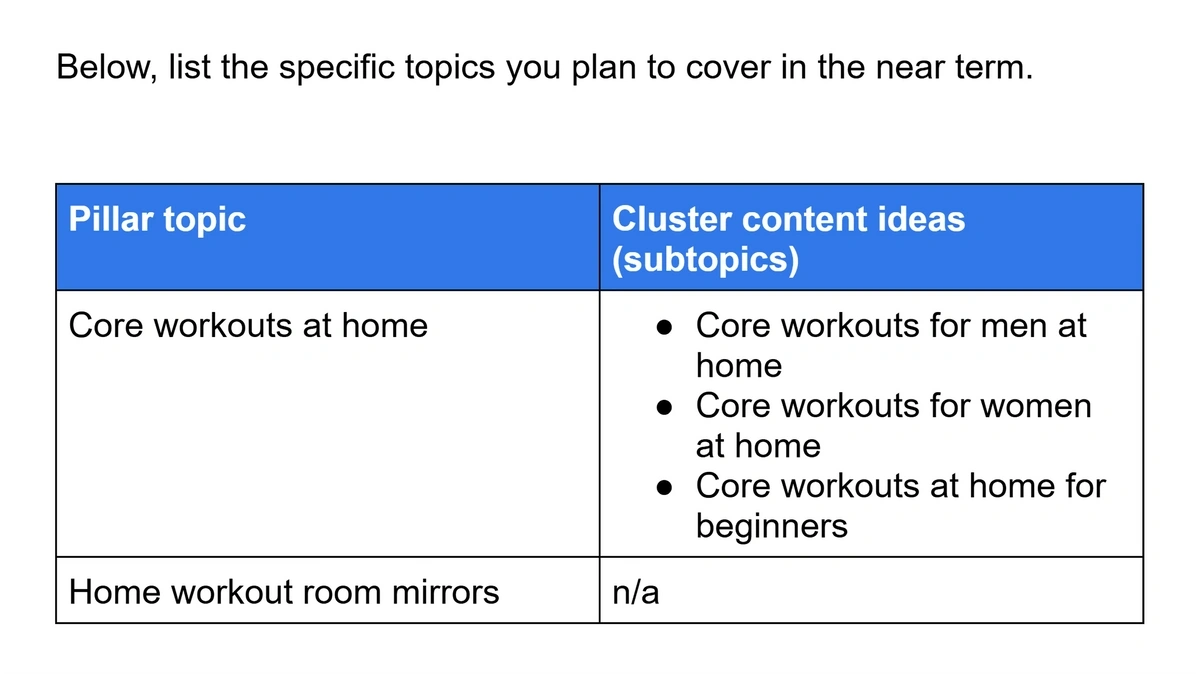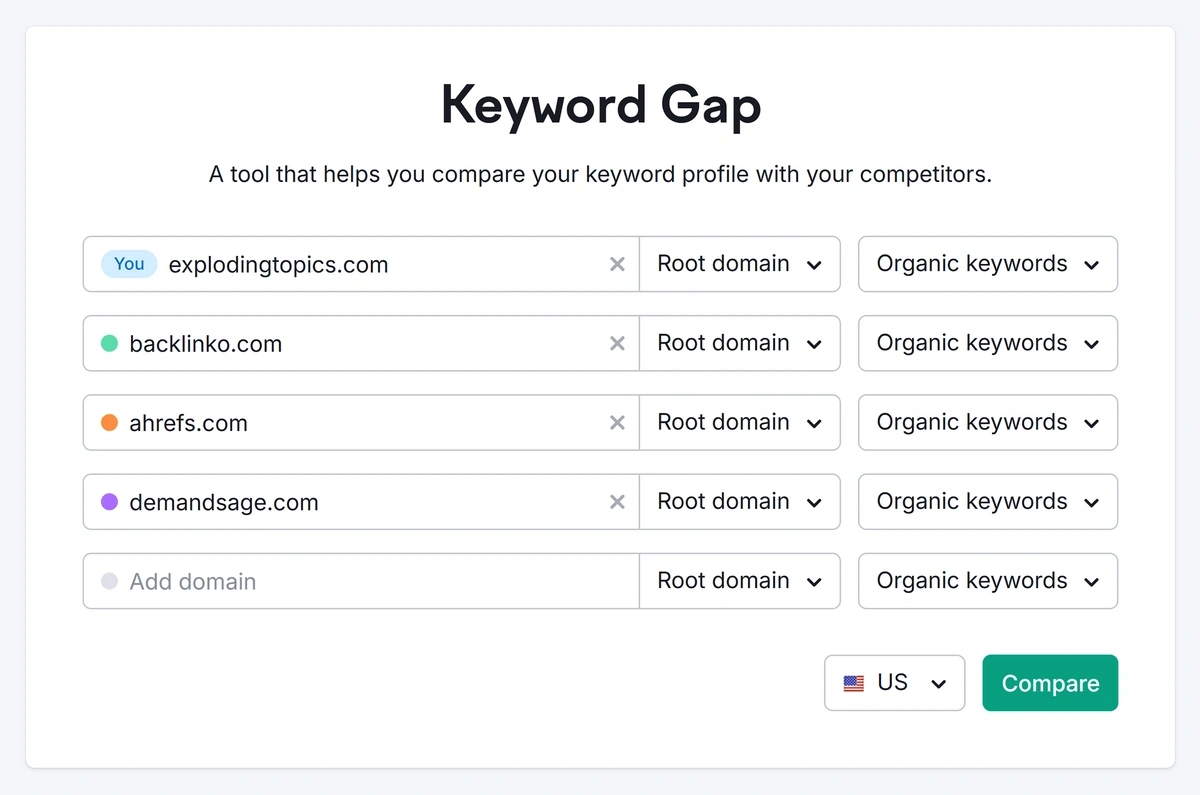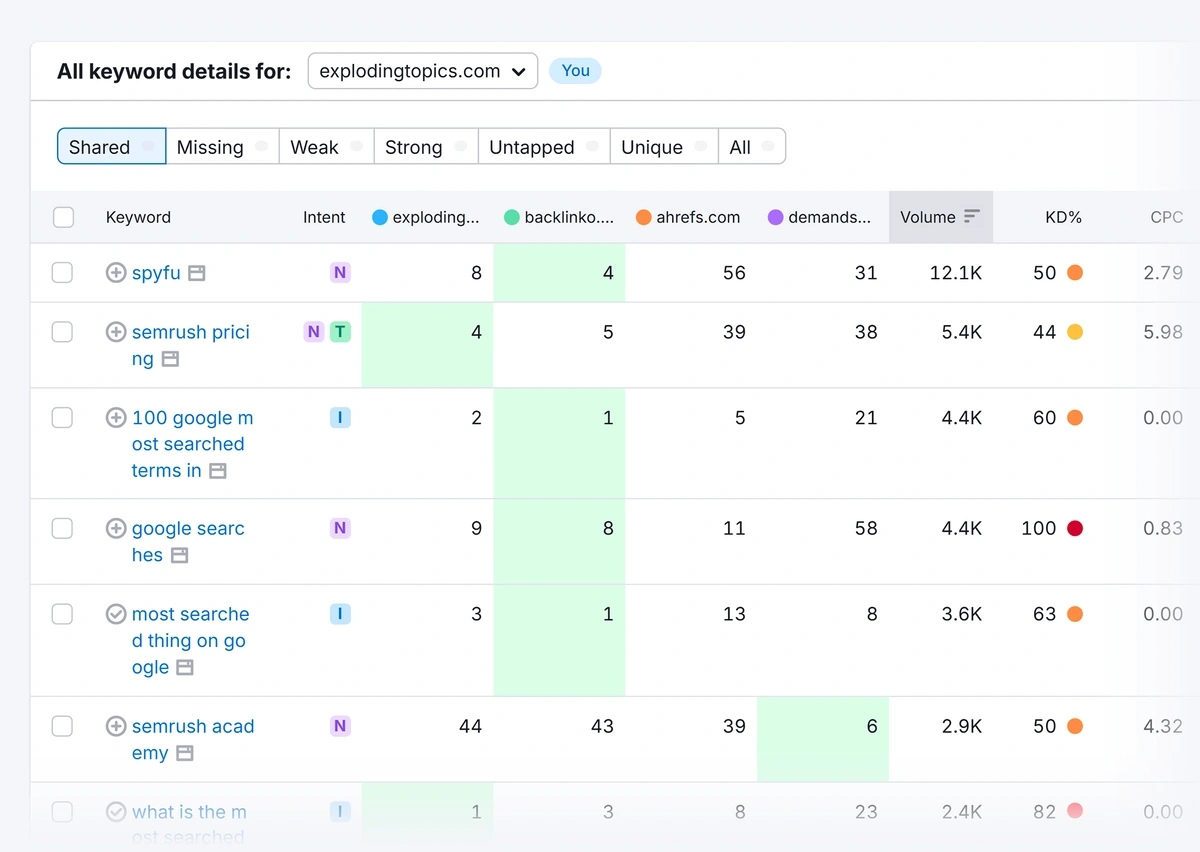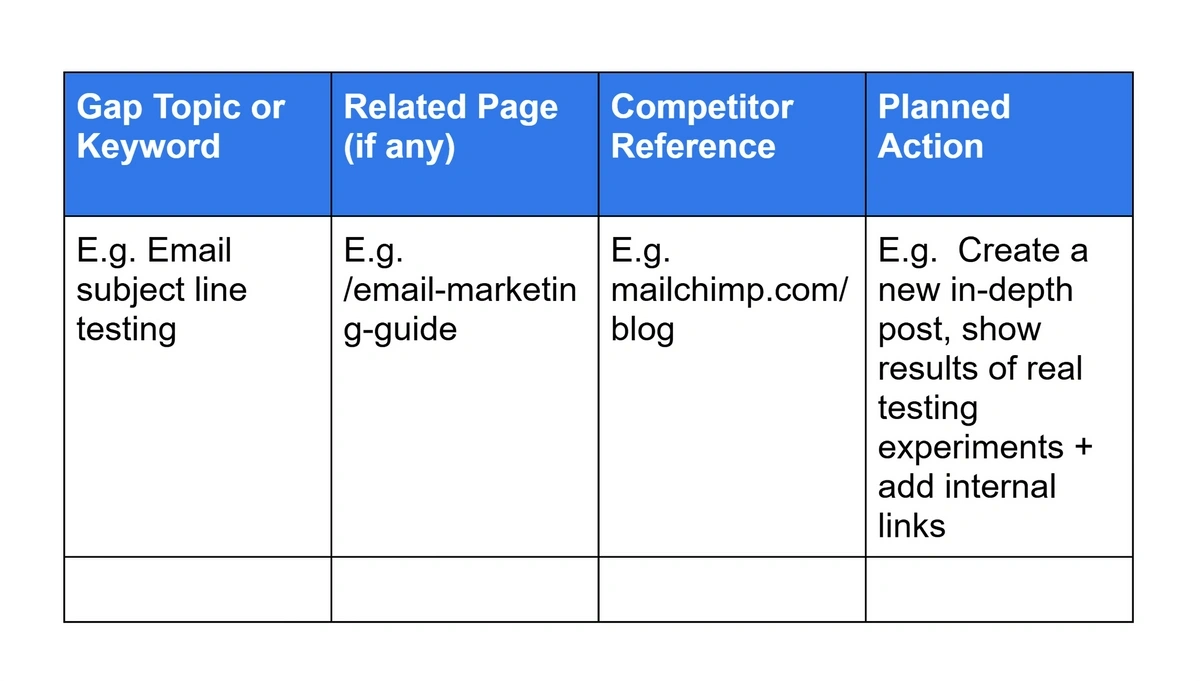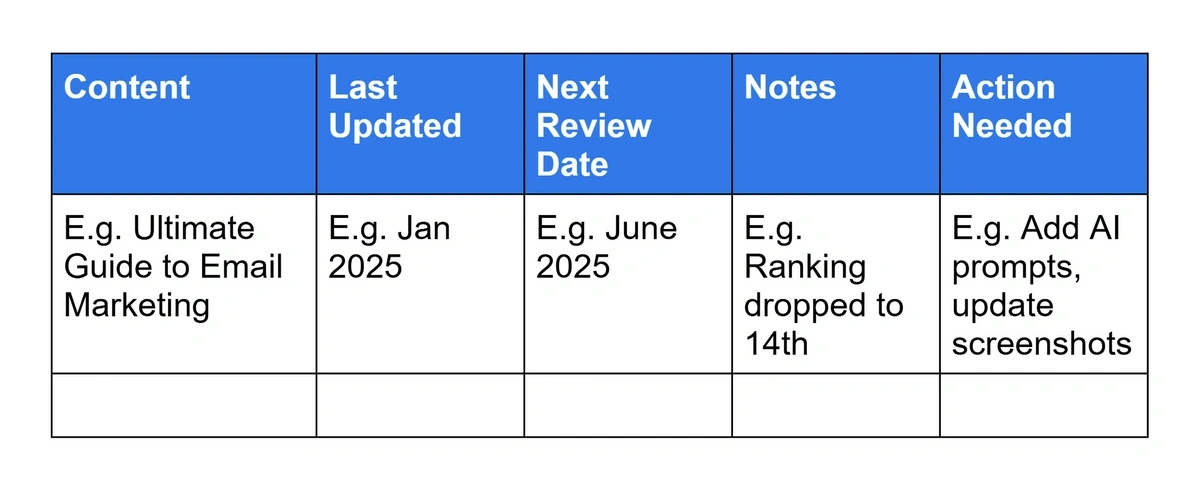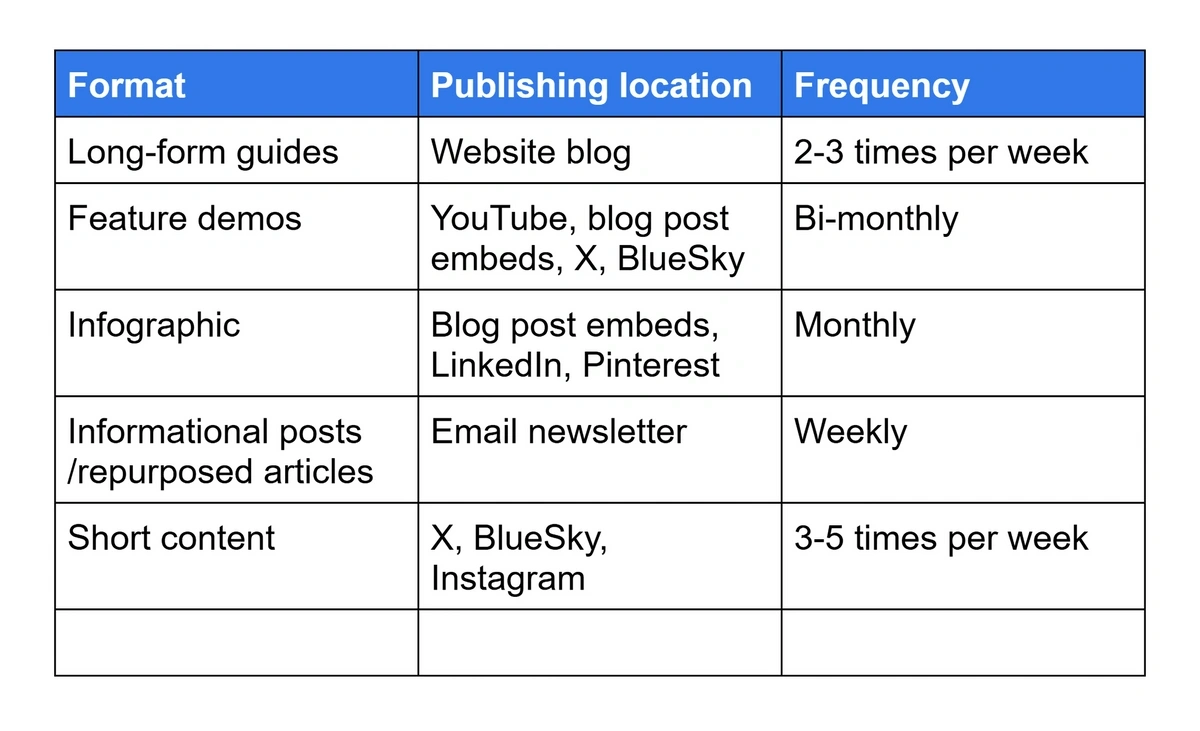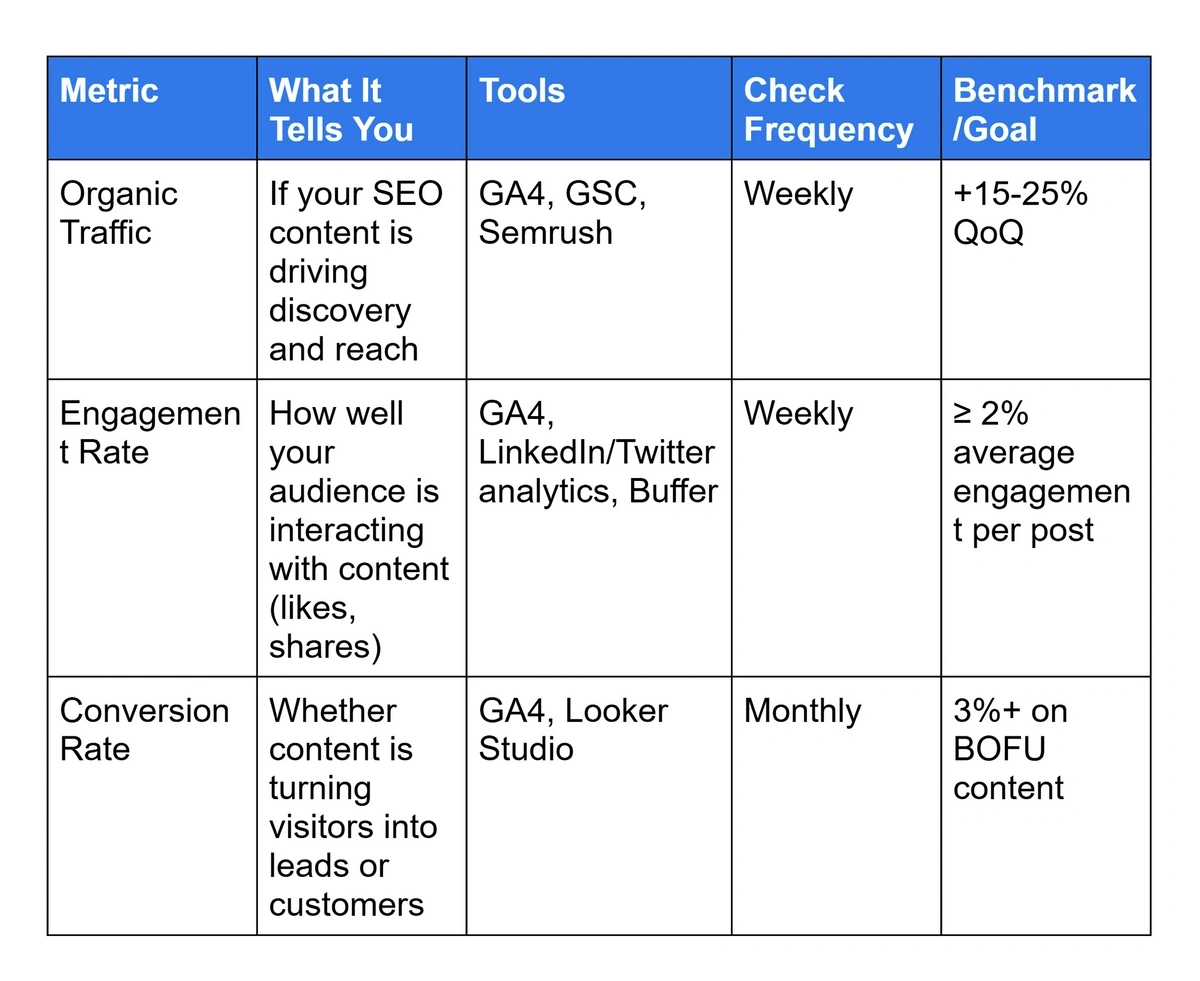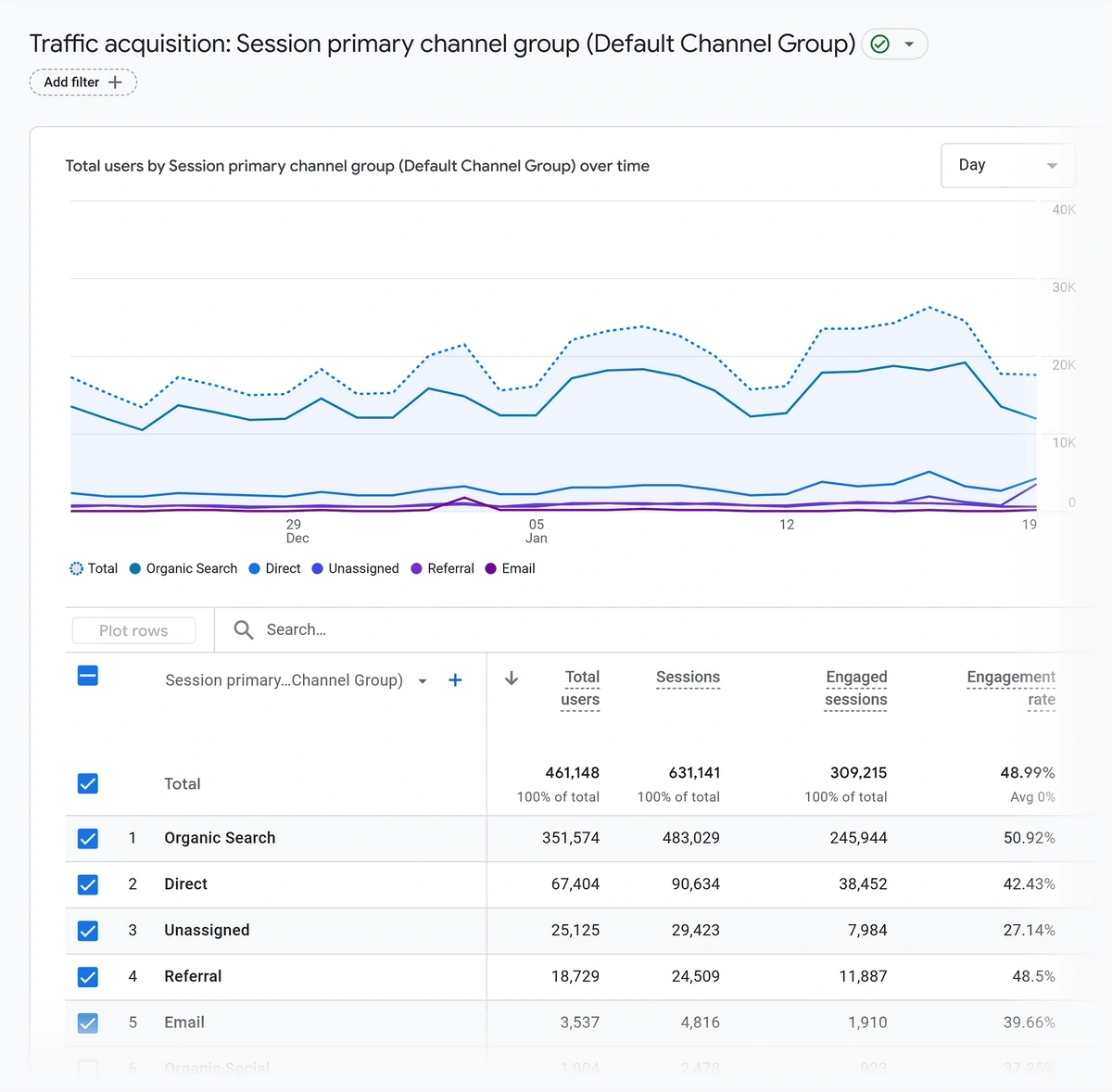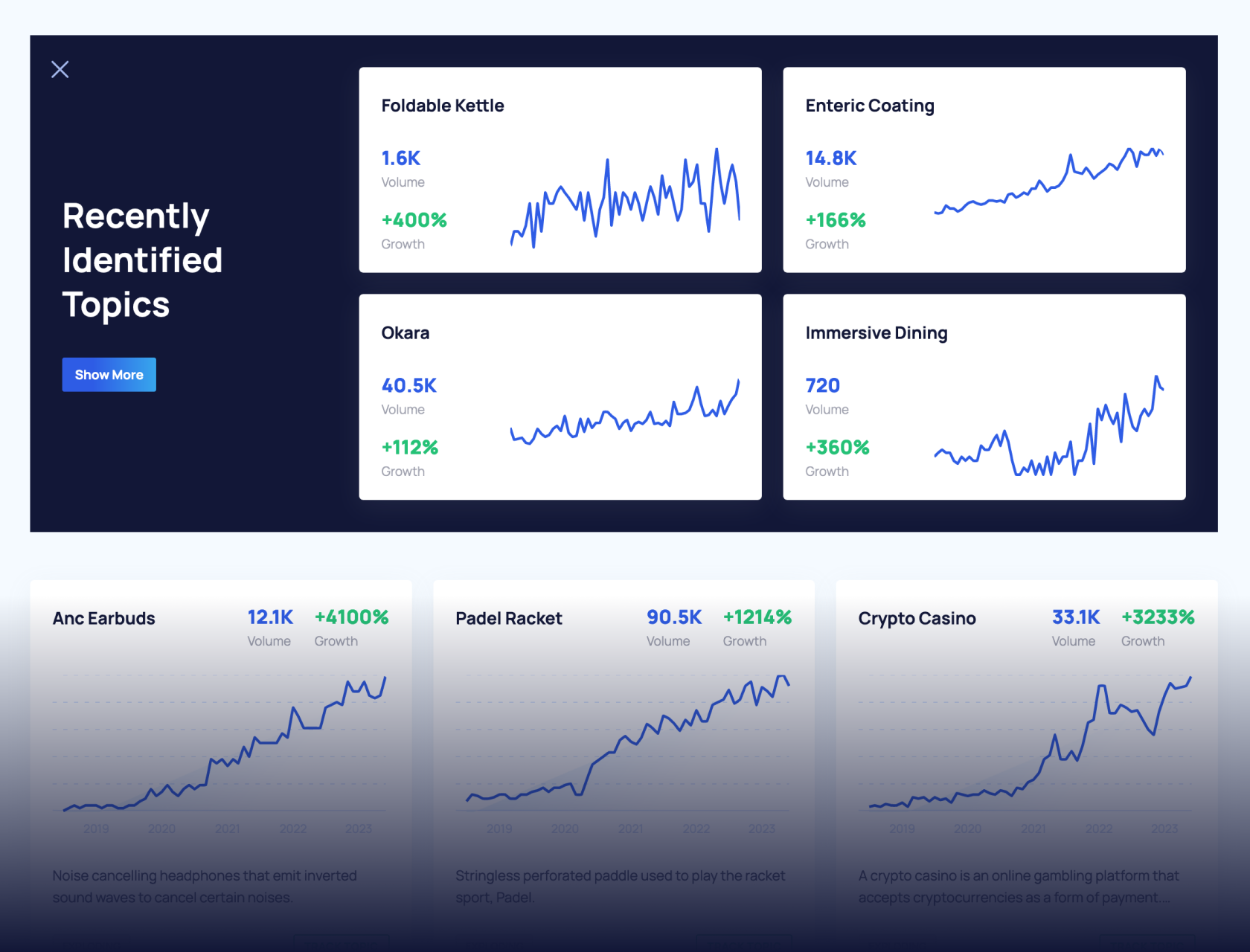
Free Content Strategy Template With Tools & Examples
Planning content is a step that businesses often ignore in their desire to move fast.
But creating a decent content strategy won’t slow you down.
In fact, a good strategy will help you SAVE time.
- It ensures you stay focused on content that’s aligned with your business goals
- It stops you wasting time on ideas that aren’t a fit
At Exploding Topics, we use a simple content strategy template that serves as the basis for everything we produce.
You can make a copy of our free content strategy template doc and follow my tips to lay down a solid foundation for your content.
Make a copy of the free content strategy template.
What tools do I need to create a professional content strategy?
I recommend 4 tools that help with different aspects of your content strategy:
- Semrush for keyword research and competitor analysis
- Google Analytics 4 for tracking metrics
- Google Search Console for monitoring search performance
- SparkToro for audience research
I’ll explain how to use them in this guide.
1. Break Down Your Business Goals
Your content strategy must address one question: what are your business goals?
Think about:
- How your content marketing goals map to your core business goals
- The growth you’re aiming to achieve
- The specific tactics you’ll use to implement your growth strategy
- The timeline in which you want to achieve your goal
- The tools you’ll need to measure progress
Let’s take the example of a SaaS company that would like to increase free trial signups.
There are many ways to achieve this goal. You’ll have a better chance if you don’t focus all your energy on a single tactic.
Instead, approach the problem from multiple angles. In this example, you’ll notice that all the content goals are directly tied to the main business goal of increasing free trial signups:
| Supporting Content Goals | Tactics / Timeframe | Tools to Measure It |
| Increase web traffic by 25% | Publish 2 SEO blog posts/week, 3 guest posts, and run 2 paid promotions targeting high-intent keywords | GA4, Search Console, UTM tracking |
| Increase conversion rate from 1.5% to 2.5% for BOFU pages | Add CTAs to top 20 BOFU pages, update sales copy on top 5 feature pages | GA4, Search Console, UTM tracking |
| Retarget non-converting blog visitors to capture 500 new leads | Launch 6-week LinkedIn/Meta ad campaign with 2 gated offers and $2,000 ad budget targeting return visitors | LinkedIn Ads Manager, GA4, Meta Pixel |
Don’t hesitate to use AI at this stage to help with planning.
I prompted ChatGPT to generate a website content strategy for a hypothetical scenario.
I used this prompt (feel free to copy it!):
I want to develop a content strategy to support a specific business goal.
Business Goal: [For example, “Acquire 600 email subscribers per month”]
Context: [Description of your product/service, target audience, and industry]
Please return a table with the following format:
Supporting Content Goals: Measurable sub-goals that directly contribute to the business goal.
Tactics / Timeframe: Specific actions to achieve the content goals, including time-bound and quantifiable elements.
Measurement Tools: Platforms or tools to track success
It came up with pretty good suggestions:
2. Create Your Ideal Customer Profile
Your content needs to speak to the people most likely to benefit from your business.
And for that, it’s important to have a clear idea of what your ideal customer looks like.
The best way to understand your audience is by collecting data from customer surveys.
For example, if you’re a SaaS company, you could integrate a simple survey into your software signup flow.
Further reading: SEO Guide for SaaS
Focus on determining who your users are and what problems they’re trying to solve.
Ask questions like:
- What’s your most difficult challenge right now related to [your product’s problem area]?
- What best describes your role or position? (Helpful in B2B contexts)
- Where did you hear about us?
Your customer support team can help, too. They interact with different kinds of customers and learn about their problems daily.
Combine your online research and primary data from your customers and fill out the audience table in our content marketing strategy template.
This exercise will help you create content that resonates with your audience.
And if you need to take a deeper dive, there are some great tools that can assist with audience research.
For instance, SparkToro can show you which social networks your audience is likely to use.
Also, Semrush Audience Demographics summarizes audience characteristics of your selected competitor domains.
I find that it helps to have a buyer persona that represents your ideal customer profile.
A buyer persona represents a fictional but data-driven profile of your ideal customer.
AI tools like ChatGPT can help you create an entire profile for someone who represents your target audience. Start with a simple prompt, like:
"Help me to create a buyer persona for someone who enjoys [activity]."
At this stage, you should have a solid idea about the people who are most likely to be interested in your content.
Now comes the next crucial task of brainstorming content topics for your audience.
3. Find Relevant Content Topics
In order for your content to reach your audience, you need to find topics that your customers are interested in.
This is where knowing your customer’s pain points will help you find relevant content ideas.
For instance, as a fitness trainer, you know a subset of your audience is interested in home workouts.
You just need a list of topics to create a strategy for delivering related content while also moving you towards your goal.
Keyword research is the best starting point.
The Semrush Keyword Magic Tool generates real keyword ideas based on your seed keyword.
(A seed keyword represents the core topic around which related keywords and content are built.)
In this case, “home workouts” is the perfect example of a seed keyword. Type this into the Semrush Keyword Magic Tool and click “Search”.
Now, you’ll have dozens of great ideas, all emerging from a single seed keyword.
You’ll find two kinds of keywords here:
- Primary keywords representing your main content topics
- Secondary keywords that should be used to enrich your main content topics.
For example, “core workouts at home”, “abs workout at home”, and “home workout equipment” are all keywords representing separate topics.
You can add these as your pillar topics in the content pillar strategy section of our template.
Content pillars serve as central themes that support multiple related subtopics in a content strategy.
Repeat the process to find subtopics for each content pillar, one by one.
Note: Not every topic needs to have a dedicated subtopic page. Long-tail keywords with a single, clear intent are usually too narrow to be clustered into subpages, such as “home workout room mirrors”.
I recommend checking out our detailed guide on finding related content ideas for a deep dive into this process.
4. Cover Content Gaps
Every successful blog content strategy needs to cover content gaps.
Use competitive analysis to identify what your rivals are doing that you’re not.
To find these topics you’re missing, you can use the Semrush Keyword Gap tool.
Type your domain name in the first field. Then add your competitors (up to 4) underneath.
Click on “Compare”.
Semrush will generate a report that shows you:
- Keywords that you share with your selected competitors
- Keywords that you’re missing or which are underperforming compared to competitors
Avoid picking any irrelevant topics that won’t move you towards your goal.
Instead, focus on opportunities related to your core topics that you might have missed.
It’s also important to avoid simply copying a competitor’s content in different words.
If you’re competing for Google rankings, you need to focus on information gain.
Information gain adds original insights or value that distinguish your content from existing material.
With the amount of generic information people are exposed to, you need to add unique value to every piece of content, even outside Google.
This will help you stand out and satisfy your audience’s need for original content that helps them solve their problems.
5. Content Maintenance and Audit Plan
It’s vital to revisit your content regularly after publishing it.
Whether it’s a YouTube video, an infographic, or a blog article, content has a short shelf life and requires frequent updates to stay relevant.
But you don’t have to stretch yourself thin updating every single piece of content.
Use the website content strategy template along with your auditing skills to prioritize content that needs maintenance on priority.
I find these criteria helpful:
- Use a position tracking tool like Semrush or Search Console to find the biggest drops in rankings
- Prioritize updates based on the value of the declining keywords (core topics first, secondary topics later)
Your core topics deserve the most frequent maintenance. Those are the topics that are critical for driving conversions and building authority.
Once you’ve identified the content that you need to improve, the next step is to determine what you need to update to make an impact.
Auditing content is a fairly involved process of its own. Our guide on web content auditing goes into considerable detail on this topic.
Quick version: you can combine manual analysis with tools like our On Page SEO Checker to find ideas for improvements.
When I’m reviewing content to improve, here are some of the things I always check for:
- Keyword usage: Are the relevant keywords used naturally with strong topic coverage?
- Search intent: Is the content satisfying search intent?
- Title: Is the title descriptive and draws attention from the target audience?
- E-E-A-T: Does the content contain strong evidence of E-E-A-T? (Experience, Expertise, Authoritativeness, and Trustworthiness is a way to evaluate content quality and credibility.)
- Engagement: Is the content structured and presented well enough to engage the consumer?
- Information gain: How original is the information shared in content?
- Freshness: Is the content outdated compared to ranking articles in SERPs?
I also recommend making use of this SEO copywriting checklist to make sure your blog content is perfectly optimized.
Once you apply these criteria to the content you’re reviewing, you can come up with a solid action plan to address existing weaknesses and turn them into strengths.
6. Choose your Content Formats
Now that you know your goals, audience, and topics, it’s time to think about how you’ll deliver your content.
Not all content needs to be a blog post. In fact, depending on your audience and goals, other formats might work even better.
So you don’t need to pick one format. But don’t try to do everything at once.
Use the audience research you performed earlier to think about where your audience hangs out and what kind of content they prefer.
For example, busy founders might prefer audio content or short-form videos. Beginner professionals might prefer detailed product comparison pages to inform their buying decisions, and so on.
Your publishing frequency is determined by the channels you’re posting on. For instance, social media requires faster posting than your blog.
But it’s not always easy to determine how often you should post on your blog.
In my experience, this decision rests on two factors:
- Your budget and resources
- Publishing frequency of your competitors
You don’t need to match the pace of your competitors. But if you’re unsure, you can determine the ideal frequency by studying what’s already working in your space.
Semrush has a great competitor monitoring tool to help with this called EyeOn.
With EyeOn, you can track blog posts, social media posts, and other competitor activities. This can give you a clear idea of how much content your competitors publish in a typical month.
7. Measurement and Tracking
Content is a game of adjustments and readjustments.
Good web content strategies start by establishing clear, quantifiable goals, as we did at the beginning of this post.
To keep things simple, start with a few core metrics. Focus on ones that directly tie back to your business goals in Step 1.
For example, consider tracking:
- Traffic
- Engagement rates
- Keyword rankings
- Keyword count
- Social media engagement
- Goal completion rates (for example, conversions or Key Events)
Then, use the table in the content strategy template to monitor them over time.
For every metric that you track, make sure to have a goal in place.
That way, when you review your tracking reports, you’ll develop a better sense of how close or far off you are from your goal and whether you need to persist with current strategies or shift things a bit.
For website content, you can track important metrics like traffic, engagement rate, and conversion rate using GA4 and Search Console.
Remember that in the GA4 traffic acquisition report:
- Session is a measure of traffic
- Engagement rate defines the percentage of engaged sessions
- Session key event is the conversion rate.
If social media is a part of your content marketing strategy, you can use your social media platform’s in-app tracking to monitor engagement stats of your social activity (likes, shares, comments, etc.)
How often should I update my content strategy?
I recommend reviewing your strategy on a quarterly basis as you measure what works and what doesn’t.
You should also review it when:
- There's a significant change in business goals
- When the current strategy isn't producing desired results
- Market conditions shift (for example, new competitors start to overtake you in search engine results)
Drive Traffic and Conversions With a Tailored Content Strategy
With your content strategy document filled out, you now have a proper strategy to refer to as you publish and maintain your content.
And it’s perfectly possible to create an effective strategy manually. But there’s more guesswork involved with this method.
You can speed things up considerably and tether your strategy to real, accurate data by signing up for a free Semrush trial.
Whether you're using tools or taking the manual route, what matters most is that you're approaching content creation with a clear plan, rather than publishing randomly and hoping for the best.
Start with our free template, measure your results, and refine your approach as your traffic grows.
Stop Guessing, Start Growing 🚀
Use real-time topic data to create content that resonates and brings results.
Exploding Topics is owned by Semrush. Our mission is to provide accurate data and expert insights on emerging trends. Unless otherwise noted, this page’s content was written by either an employee or a paid contractor of Semrush Inc.
Share
Newsletter Signup
By clicking “Subscribe” you agree to Semrush Privacy Policy and consent to Semrush using your contact data for newsletter purposes
Written By


Osama is an experienced writer and SEO strategist at Exploding Topics. He brings over 8 years of digital marketing experience, spe... Read more

